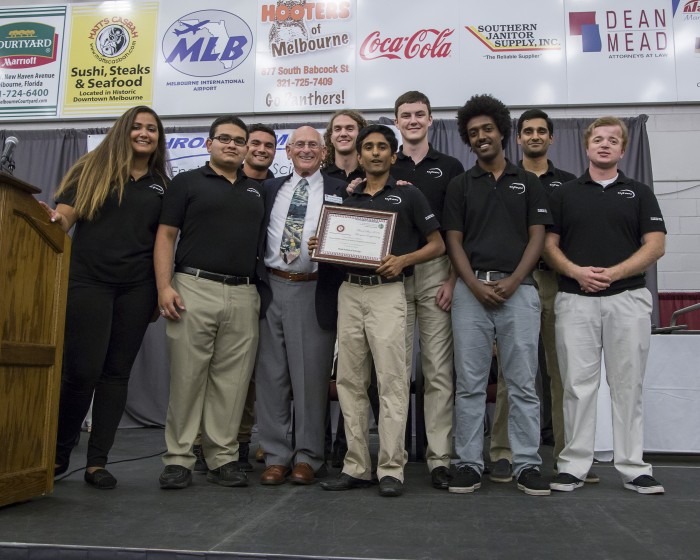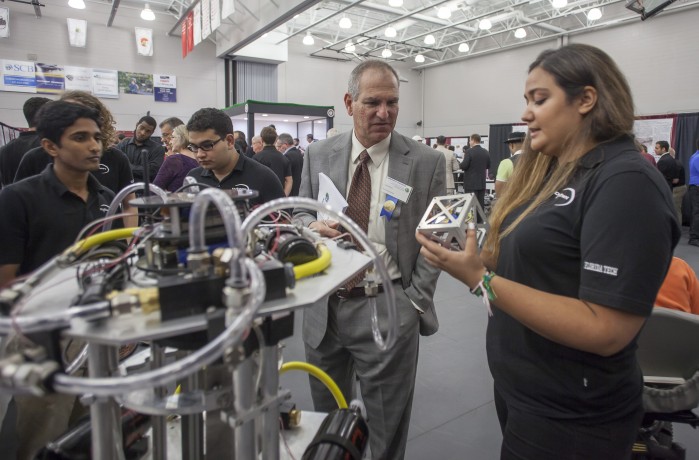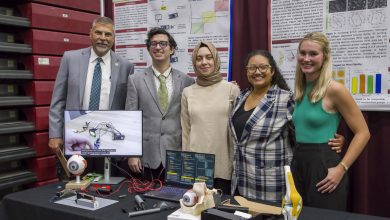Aerospace Students Aim to Bring Microgravity to Earth
If you can’t go to space, then you bring space’s microgravity environment to you. And that’s what one of Florida Tech’s student design team is creating. The team, comprised of nine aerospace engineers, have created a system that has the potential to recreate microgravity for lab testing.
Project DAWN (Diverse Air-bearing Weightless eNvironment) consists of building two systems; a spacecraft testbed and a CubeSat. Using air-bearing technology, which works based on the same principle as an air hockey table, they are going to enable frictionless motion, simulate microgravity and recreate the dynamics of space in a lab.
 Group leader John Poothokaran said their project will provide a spacecraft testbed that will be available to academia and industry for spacecraft dynamics and control research. It will enable a diverse range of experiments in the ORION Lab at Florida Tech and can be used to further the Technology Readiness Levels (TRLs) of Space Systems. The CubeSat will be used for high precision attitude control research.
Group leader John Poothokaran said their project will provide a spacecraft testbed that will be available to academia and industry for spacecraft dynamics and control research. It will enable a diverse range of experiments in the ORION Lab at Florida Tech and can be used to further the Technology Readiness Levels (TRLs) of Space Systems. The CubeSat will be used for high precision attitude control research.
“The opportunity to work on engineering systems that would be used for research for several years and the ambitious goals of the project motivated us to pursue the project,” Poothokaran said.
The testbed can carry a 10 kg experimental payload for a 30 minute experiment. The testbed will move across a lab floor using flat air bearings and uses a frictionless pulley system. It also simulates microgravity in the vertical direction using a counter weight deck. 12 Cold gas thrusters are mounted on the testbed for 6DOF motion control.
Poothokaran said the team is the first undergraduate team in the world to build a fully a dynamic 6DOF Testbed. Their hard work paid off during this year’s Northrop Grumman Engineering & Science Student Design Showcase — they took home best in show for aerospace engineering.

The CubeSat has a 10 cm cube structure, with a reaction wheel control system that controls orientation and rotational motion. It will be the first payload on the testbed, which will be used for research in the ORION Lab at FIT.
“The challenges that the team faced through the manufacturing and assembly process has given us a new perspective on engineering design and the process of building an idea into reality,” Poothokaran said.
Poothokaran believes student design is an important part of the college experience.
“It exposes the students to the process of applying theoretical knowledge towards a specific objective and gives students experience working in teams,” Poothokaran said. “The real problems that arise during different parts of a project have taught me to be alert and ready to tackle problems.”
Visit http://www.fit.edu/student-design to learn more about student design and research at Florida Tech.





